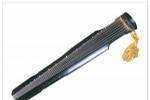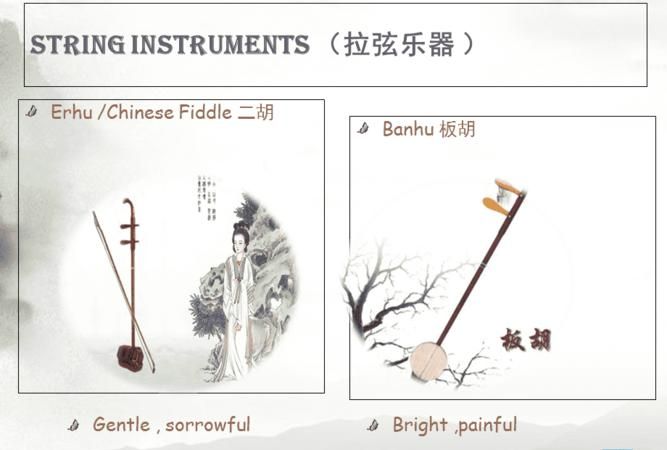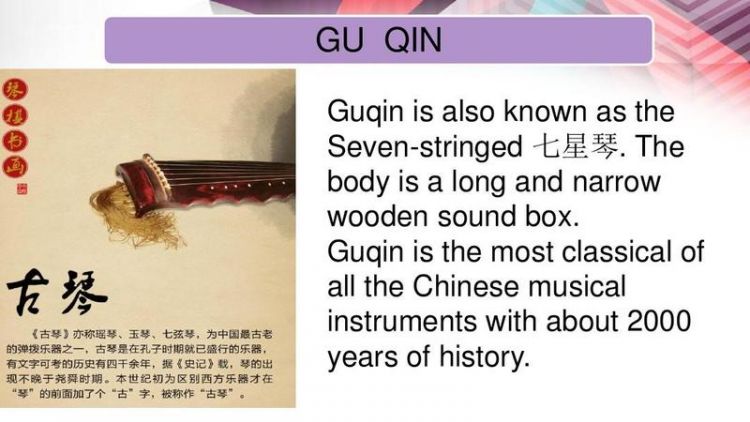本文目录
中国古典乐器英文介绍
古琴:Qin, also known as Yao Qin, Yu-Qin, a lyre, for the Chinese one of the oldest plucked instruments, the qin is already prevalent in the Confucian period instruments, there are words to consider the history of thousand years, according to "Historical Records" contains, The emergence of Qin period no later than Yao and Shun. The beginning of this century, only for the distinction of Western instruments in the "piano" added in front of a word "historic", called "Qin." Still ringing in his study so far, the ancient musical instruments on stage.
巴乌Bau, is a bamboo reed instruments copper, spring for the tongue. The Yi, Hani, Dai, Wa, Blang, Miao and other ethnic wind instruments. Yi called the local "and Fei Limo", Hani called "Meiba." Bau is popular in southwest China Yi, Miao, Hani and other single-reed wind instrument family, Bau is made with bamboo, has eight finger holes (seven before the latter), disposed in the mouthpiece of a brass reed tongue tip, blowing across the top of playing, vibrating reed sound. Bau smaller volume, but the sound soft, southwest China's people call it a talking instrument. Bau popular in the Red River in Yunnan Province, Wenshan, Simao, Xishuangbanna, Lincang, Dehong, meltwater Guangxi Zhuang Autonomous Region, Guizhou Province, Guizhou and South Guizhou and other places.

中国古典音乐的特点英语介绍
这种民族乐器的英语就用汉语拼音,然后加些注释
琵琶 The pipa - is a plucked Chinese string instrument. Sometimes called the Chinese lute, the instrument has a pear-shaped wooden body. It has been played for nearly two thousand years of history in China, and belongs to the plucked category of instruments
古筝 guzheng - is a traditional Chinese musical instrument. It belongs to the zither family of string instruments.
扬琴 yangqin - is a Chinese hammered dulcimer originally from Persia (modern-day Iran). It used to be written with the characters
长笛就是 Flute
名曲也一样
gao shan liu shui高山流水 meaning high mountains and flowing waters
Shi mian Mai fu十面埋伏 meaning ambush from ten direction
Er quan ying yue二泉映月 meaning the second moon-reflecting spring
中国古典音乐一些英语资料
Chinese classical music is the traditional art or court music of China. It has a long history stretching for more than three thousand years. It has its own unique systems of musical notation, as well as musical tuning and pitch, musical instruments and styles or musical genres.
Chinese music is pentatonic-diatonic, having a scale of twelve notes to an octave (5+7 = 12) as does European-influenced music.
Music of China appears to date back to the dawn of Chinese civilization, and documents and artifacts provide evidence of a well-developed musical culture as early as the Zhou Dynasty (1122 BC - 256 BC).
According to Mencius, a ruler had asked Mencius whether it was moral if he preferred pop songs to the classics. The answer was that the only thing matters being whether or not he loved his subjects.
The Imperial Music Bureau, first established in the Qin Dynasty (221-207 BC), was greatly expanded under the Emperor Han Wu Di (140-87 BC) and charged with supervising court music and military music and determining what folk music would be officially recognized. In subsequent dynasties, the development of Chinese music was strongly influenced by foreign music, especially that of Central Asia.
Traditional orchestral instruments
* Woodwind and percussion
o dizi, sheng, paigu, gong, paixiao, guan, bells, cymbals
* Bowed strings
o erhu, zhonghu, dahu, banhu, jinghu, gaohu, gehu, yehu, cizhonghu, diyingehu, leiqin
* Plucked and struck strings
o guqin, sanxian, yangqin, zheng, ruan, konghou, liuqin, pipa, zhu
Chinese vocal music has traditionally been sung in a thin, nonresonant voice or in falsetto and is usually solo rather than choral. All traditional Chinese music is melodic rather than harmonic. Chinese vocal music probably developed from sung poems and verses with music.
Instrumental music
Instrumental pieces played on an erhu or dizi are popular, and are often available outside of China, but qin, pipa and zheng music, which are more traditional, are more popular in China itself. The qin is perhaps the national instrument of China, and its virtuosos are stars. These include Zha Fuxi, Wu Wen'guang, Lin Youren, Wu Jinglue, Wu Zhaoji, Guan Pinghu, Zhang Zijian, Li Xiangting and Gong Yi. The zheng, a form of zither, is most popular in Henan, Chaozhou, Hakka and Shandong. The pipa, a kind of lute, believed to have been introduced from the Arabian Peninsula area during the 6th century and improved, is most popular in Shanghai and surrounding areas.
Opera
Chinese opera has been hugely popular for centuries, especially Beijing opera. The music is often guttural with high-pitched vocals, usually accompanied by suona, jinghu, other kinds of string instruments, and percussion. Other types of opera include clapper opera, Pingju, Cantonese opera, puppet opera, Kunqu, Sichuan opera, Qinqiang, ritual masked opera and Huangmei xi.

用英语介绍中国乐器
古筝
ancient
zither
【十三弦古筝
koto】
古琴
可以翻译成
Gu
Chin
Lyre是古希腊的一种古琴
中国的也可说成
Chinese
Lyre
琵琶
Lute
二胡
two-stringed
Chinese
fiddle
扬琴
cymbalo
也有
dulcimer
说法
木琴
xylophone
或者
marimba

中国民族乐器历史悠久英文翻译
Chinese national musical instruments, has a long history goes back to ancient times. The cultural relics unearthed from others can confirm that: far in the pre-Qin period, there is a wide range of musical instruments.
2. These foreign musical instruments, after constantly improving, so that they gradually become China's national musical instrument family member.
3. China's "Blow, to fight, bombs, and Latin America," the four major types of musical instruments, has gone through a long historical period.

以上就是关于用英文介绍中国古典乐器 ,中国古典乐器英文介绍的全部内容,以及用英文介绍中国古典乐器 的相关内容,希望能够帮到您。

